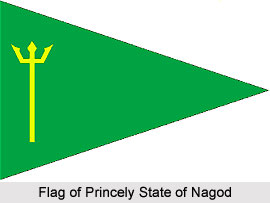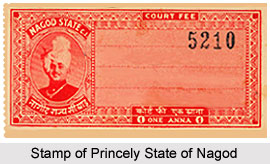 The Princely State of Nagod was one of the former 9 Gun Salute states of India that was under the indirect rule of the British Empire in India. The region covered a total area of 501.4 sq miles and comprised of a population of 87,911 in the year 1941. Nagod state, also known as Unchahra or Unchahara, was located in Baghelkhand. It was bounded by the Sohawal in the northeast; Rewa in the east; Maihar in the south; and Jaso and Ajaigarh in the west. The state of Nagod included 333 villages and 2 towns in the 1941. It was incorporated as a part of the Bundelkhand Agency, under Central India Agency.
The Princely State of Nagod was one of the former 9 Gun Salute states of India that was under the indirect rule of the British Empire in India. The region covered a total area of 501.4 sq miles and comprised of a population of 87,911 in the year 1941. Nagod state, also known as Unchahra or Unchahara, was located in Baghelkhand. It was bounded by the Sohawal in the northeast; Rewa in the east; Maihar in the south; and Jaso and Ajaigarh in the west. The state of Nagod included 333 villages and 2 towns in the 1941. It was incorporated as a part of the Bundelkhand Agency, under Central India Agency.
History of Princely State of Nagod
The Pratihara or Parihar Rajputs were the ruling family of Nagod. The Parihars established themselves in the region near Chhatarpur during the 7th century. A considerable segment of the dynasty was compelled to move east in the 9th century by the Chandel Rajputs. After which the Parihars declined in power. The territory of Nagod was established in the year 1344, when Raja Dhara Singh captured the fort of Naro. Raja Bhoja made Unchahra his capital in 1478; but it was later moved to Nagod in 1720. During the 18th century, the Parihar Rajputs lost all their lands to Baghelas and Bundelas, except for the state of Nagod. They were able to conserve the state by surrendering to their enemies. After the Treaty of Bassein in the year 1803, the British administration gained supremacy in Bundelkhand and Nagod became a tributary to Panna. The princely state of Nagod was made a tributary to Panna from the year 1807 to 1809. In recognition of the family`s possession of its holdings under Chhatarsal and Ali Bahadur of Banda, a distictive sanad was granted to Raja Lal Sheoraj Singh in 1810, confirming him in his possessions.
In 1820, Nagod was appointed as a tributary to Panna and was incorporated in the sanad granted to that state in 1807. But a separate sanad was granted to Lal Sheshraj Singh in 1809, which confirmed him his possessions. In the year 1830, the British Government of India attempted and overthrew his successor for the assassination of his brother. The Indian princes, who were acting in an advisory capacity, were invited to support the Resident of British India in arriving at a verdict and decide on the penalty to be carried out to a fellow chief. After the great revolt of 1857, Raghvendra Singh, the native ruler, provided loyal services to the British forces and was consequently rewarded by the grant of 11 villages, which earlier belonged to the state of Bijeraghogarh (Vijayraghavgarh).
 The Princely State of Nagod was accorded as one of the salute states of India with a gun salute of 9 guns. The native ruler of the state, who held the title of Raja, took charge of the administration of the state and was assisted by an executive council. A legislative assembly was established with a majority of elected members. Nagod state was one of the original constituent members of the Chamber of Princes, a number of smaller states indirectly represented by 12 princes who were elected periodically by them. In the year 1940, the Raja of Nagod was admitted to the Chamber in his own right.
The Princely State of Nagod was accorded as one of the salute states of India with a gun salute of 9 guns. The native ruler of the state, who held the title of Raja, took charge of the administration of the state and was assisted by an executive council. A legislative assembly was established with a majority of elected members. Nagod state was one of the original constituent members of the Chamber of Princes, a number of smaller states indirectly represented by 12 princes who were elected periodically by them. In the year 1940, the Raja of Nagod was admitted to the Chamber in his own right.
After the nation attained independence and the withdrawal of the British Government of India, the princely state of Nagod was acceded to the newly independent Union of India. At present, Nagod is a Nagar Panchayat and a town in the district of Satna in Madhya Pradesh state, India.
Rulers of Princely State of Nagod
The list of the native rulers of the princely state of Nagod are mentioned as follows-
* Raja Fakir Shah (1685- 1721)
* Raja Chain Shah (1720- 1748)
* Raja Ahilad Singh (1748- 1780)
* Raja Sheoraj Singh (1780- 1818)
* Raja Balbhadra Singh (1818- 1831)
* Raja Raghubindh Singh (1831- 1874)
* Raja Jadubindh Singh (1874- 1922)
* Raja Narharendra Singh (1922- 1926)
* Raja Mahendra Singh (1926- 1947)






































